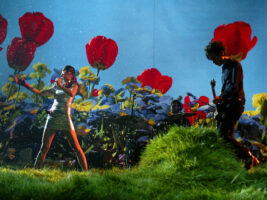
The Genius Of… Fever to Tell by the Yeah Yeah Yeahs
You’d expect a debut album for a band to set the precedent for what the world at large should expect, and offer some insight into what they’re setting out to do – but in the case of New York indie-rockers the Yeah Yeah Yeahs, they’d already done that before their first full-length even hit the shops.
READ MORE: Kim Thayil on how the Guild S-100 defined Soundgarden, and why he’s teamed up with the brand to bring it back
In fact, the trio had made such an impact that their self-titled EP had made such a splash that even on the other side of the Atlantic, NME saw fit to name it the second best single of 2001.
Of course, it didn’t hurt that the Yeah Yeah Yeahs were blossoming into what was at the time the hottest music scene on the planet – books and films have been made about what an exciting and febrile place the New York music scene was in the first decade of the 2000s, and the Yeah Yeah Yeahs were right in the thick of it.
What’s more, the band were perfectly placed to step into the void vacated by The Strokes and Interpol who had begun to ascend to megastardom, making their debut album one of the most hotly anticipated of the era. It didn’t disappoint.
So what was so special about this album then? Some might say it defined art-school punk in the early ’00s, going beyond garage rock’s occasional penchant for rudimentary musicianship, adding a layer of complex guitar accompaniment to the band’s sound.
For frontwoman Karen Orzolek (AKA Karen O), however, one thing was abundantly clear – they wanted to be different.
“When we started the Yeah Yeah Yeahs, it was at a point in New York where we weren’t very interested in anything that was happening music-wise and wanted to rock the boat a bit,” Orzolek explained during their performance on Live! from Central Park SummerStage in 2004. “[There was] a lot of really eclectic bands coming up and we came up with that.”
Karen O and Nick Zinner of The Yeah Yeah Yeahs performing onstage in 2004. Image: Tim Mosenfelder/Getty Images
“Both big and punk”
“I’m rich”, murmurs O in opening track Rich, as Nick Zinner’s guitar whirrs like a sine wave, and the bass punches in. There’s certainly a uniqueness to The YYY’s musicality, mixing the eclectic primal screams with the classic punk tones, as she navigates the band’s sound.
As noted by Robert Christgau in The Village Voice, the album delivers “a striking sound” that is “both big and punk, never a natural combo”. This can certainly be credited O’s enthusiastic energy throughout the album, as she manages to match the relentlessness of the instrumentation, without any compromise.
Take Tick for example. No matter how complex or fast-paced Zinner and drummer Brian Chase perform, she is right there matching that energy every step of the way. She even goes as far as singing along to the guitar parts, as heard in Pin, helping to achieve this “big” sound expressed by Christgau with minimal instrumentation.
Ah yes, the lack of bass – The White Stripes had blazed a trail for bass players being optional a few years previous of course, but even in a live setting at this point the only instruments used were drums, drum machines, and the guitars of Zinner and O.
While the trio would be complimented with a live fourth member who would switch between bass, keys and guitar as needed (Imaad Wasif in 2006, and then Slint’s David Pajo from 2009 onwards) the power and depth they could generate as a trio is in full evidence on Fever To Tell – check out the archly titled No No No, which brings a serious amount of low-end thump, despite the use of just two instruments.
The weakest link or the linchpin?
The trio had and still have quite the electric stage presence – something that clearly helped in their ascent to stardom in the early ’00s. However, the nonchalant attitude of O both on stage and on the record felt through tracks like Cold Light, which sees cocky guitar riffs and overdriven punky solos accompanied by O’s speech like lyrics.
Despite her prominent position in the band, this attitude has unfortunately led to accusations about the importance of her input in The YYY’s, or on the other hand, the lack of importance of her band mates.
“While the guys are definitely on here,” explains Pitchfork, “they’re still nowhere near ground-breaking, and as a result, they rise and fall depending largely on Karen’s delivery.”
However, to agree with this stance, is to undermine the talent that it takes to write guitar and bass parts that work alongside O’s unique style. Even in breakout single Maps the way that the guitar weaves with O’s wildly varied vocal delivery shows the telepathy the musicians shared. Similarly, in final track Poor Song, the guitar doesn’t overpower, instead it flatters. Acting as an acapella voice, accompanying her throughout the song.
If this album was hyped then, the Yeah Yeah Yeahs made sure that people got what they were waiting for – the most accurate and effective distillation of what they set out to achieve. “There are half a dozen songs under three minutes on Fever to Tell,” explains Rolling Stone, “and they sound absolutely complete.”
It’s a remarkable achievement that owes just as much to the wonderfully inventive and messy guitar lines as it does O’s commanding and beguiling vocal performance. With a grab-bag of punk, indie-rock, classic rock and even electronic influences thrown in, Zinner takes listeners on a wonderful sonic journey that always keeps you on your toes.
Best Guitar Moment
Tick
The post The Genius Of… Fever to Tell by the Yeah Yeah Yeahs appeared first on Guitar.com | All Things Guitar.
Source: www.guitar-bass.net











